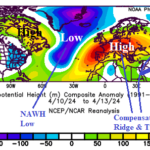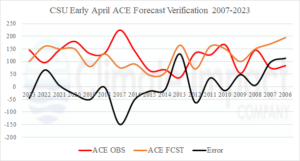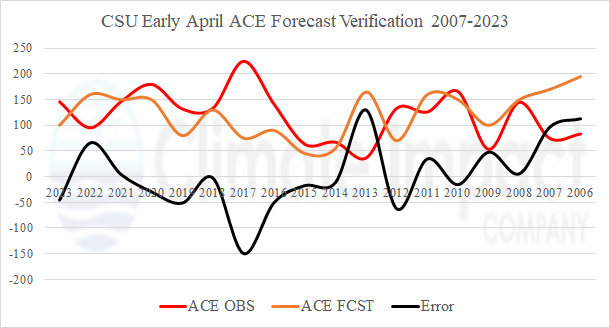
The March 2024 Global Marine Heat Wave Discussion and Outlook
03/20/2024, 3:58 pm EDT
MJO, NAWH, and IOD Contribute to Southern Ural Region/Northern Kazakhstan to Dubai Flooding
04/17/2024, 2:59 pm EDT
Fig. 1: The ACE index from early April tropical cyclone season forecasts for the North Atlantic basin by Colorado State University compared to observed and the error.
Discussion: Surprisingly, early April accumulated cyclone energy (ACE) forecasts for the following tropical cyclone season issued by Colorado State University have limited skill. The average error during the 2007-2023 period is 45. Of the 17 years since seasonal ACE forecasts were generated, 6 years were (well) under-forecast, 5 years were (well) over-forecast, and 6 were reasonable (within 30). The most dramatic forecast errors occurred in 2017 (-150), 2013 (+129), and 2007 (+96). In 2017, one of the strongest tropical cyclone seasons on record (ACE index 225) was observed. The super-active season occurred due to the unexpected arrival of a rapidly developing La Nina. In 2013, minimal ACE (36) was observed following a very active forecast. The unexpected issue was evolution of a tropical upper tropospheric trough (TUTT) preventing storms from intensifying. Finally, in 2007 an observed low ACE value (74) was unexpected due to a very active forecast. The issue was two early season major hurricanes (Dean and Felix) across the length of the North Atlantic tropics up-welling cool subsurface water diminishing upper ocean heat for following storms to flourish. The best forecast for the most active season was in 2021 when an ACE forecast of 150 compared to 146 observed.
![Climate-Impact-Company-logo-sm[1]](https://climateimpactcompany.com/wp-content/uploads/2023/08/Climate-Impact-Company-logo-sm1.png)
